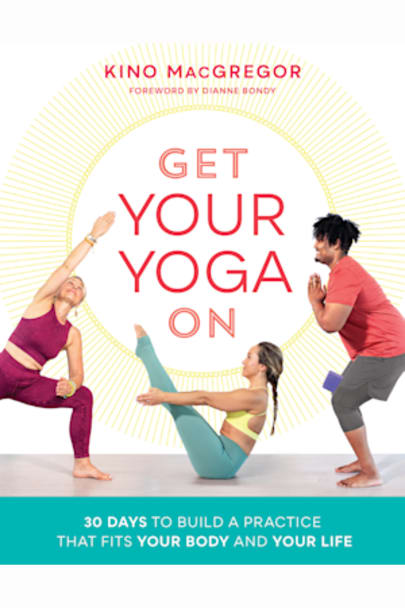Yoga is a healthful, stress-busting, powerfully life-changing practice that is truly for everyone! You don’t need to be young, flexible, or athletic to do yoga, and you don’t need to spend hours on the mat. You just need to be yourself and commit to practicing at least five minutes a day. Here, renowned yogi Kino MacGregor presents a basic, self-paced plan to encourage you to try each of the … of the thirty foundational poses included and slowly build a regular yoga practice. Through step-by-step instructions, over two hundred color photographs, and modifications for different body types and abilities, Kino makes yoga possible at whatever level you may be. By challenging yourself for just five minutes a day, you will end up learning a strong, basic yoga sequence that you can grow and adapt for a lifetime of yoga.
more



I have been practicing yoga for the past 25 on and off – more off than on sometimes and always at the beginner to intermediate level. The trouble is that the books always show the poses as done by the advanced or expert yogi which does not do much good for the beginner, who really needs to see what is incrementally attainable as s/he develops a yoga practice. I can think back to many classes that did not help as the instructor would try to have us reach for the perfect asana.
Kino MacGregor understands very well that the beginning yoga student does not attain the perfect pose, nor should s/he work towards it right away. MacGregor has a refreshing outlook and approach to yoga that starts the beginner or the new student to “come to yoga from wherever you are.” Gone are the days of pictures of yogi with the perfect bodies and BMI, here we have a book where the pictures illustrating the asanas are students who are the real people in your class. One of the best lines of Get Your Yoga On that expresses MacGregors approach is “The perfect body for yoga practice is the one you have.”
“Perfect is the enemy of the good” wrote Voltaire, meaning for me that illustrating only the perfect yoga asanas does not necessarily help the new student. MacGregor understands this: For each of the asanas, she has a number of alternatives to the pose for which one or more may be achievable by the student. In each case, you will find a description accompanied by pictures illustrating students – not yogi – in the alternative poses. It is far more instructive to see someone you can identify with than just the yoga instructor. That is not to say the ideal pose is not valuable to see – each asana has an illustration of the ideal pose and the variations have illustrations of students and their ability to attain the pose. I think in this way, the reader can see the perfect pose, see variations that students can achieve and so the reader has a realistic plan for developing a practice of individual poses and a complete practice.
A strong feature of the book is that for each of the 30 poses, MacGregor starts with a photograph of the ideal pose and a description of how to get into the pose. This is followed by a number of alternate variations, with pictures of students in the pose. The photography is excellent, the choice of students is good as it demonstrates a variety of body types to the reader. The one detractor for me are references to muscles and muscle groups as this is probably lost to the lay reader. I think most people may know what a hamstring is, but not a deltoid. A short introduction to anatomy might help.
In summary though, don’t let this bother you. Buy the book and use it to it’s fullest. I can replace most of my yoga references with Get Your Yoga On. The yoga challenge as outlined in the book is a great way for the beginner or novice to get started and is an excellent modern-day reference for the more advanced practitioner.
I would like to thank the author, Shambala press and Edelweiss+ for the advanced reader copy of Get Your Yoga On. I have voluntarily left this review.